The Portrayal of American Indigenous People in Popular Culture
VerifiedAdded on 2020/04/13
|9
|2187
|54
Essay
AI Summary
This essay provides a comprehensive analysis of the representation of American Indigenous people in popular culture, examining how they have been portrayed across various media forms, including literature, film, sports, art, and video games. The paper explores the historical context of these representations, highlighting the evolution of stereotypes and the impact of these portrayals on Indigenous identity and self-perception. It delves into the complexities of cultural appropriation, the use of mascots, and the perpetuation of inaccurate or harmful stereotypes. The essay also discusses the positive and negative impacts of media representation, particularly on younger generations, and emphasizes the importance of accurate and respectful portrayals. It references the work of several academics and researchers who have studied this topic. The paper concludes by arguing for the need for more nuanced and authentic representations of American Indigenous people in popular culture to foster greater understanding and respect. The essay uses a variety of sources including books, journal articles, and online resources to support its claims.

Running head: AMERICAN INDIGENOUS PEOPLE IN POPULAR CULTURE
AMERICAN INDIGENOUS PEOPLE IN POPULAR CULTURE
Name of the Student:
Name of the University:
Author Note:
AMERICAN INDIGENOUS PEOPLE IN POPULAR CULTURE
Name of the Student:
Name of the University:
Author Note:
Paraphrase This Document
Need a fresh take? Get an instant paraphrase of this document with our AI Paraphraser
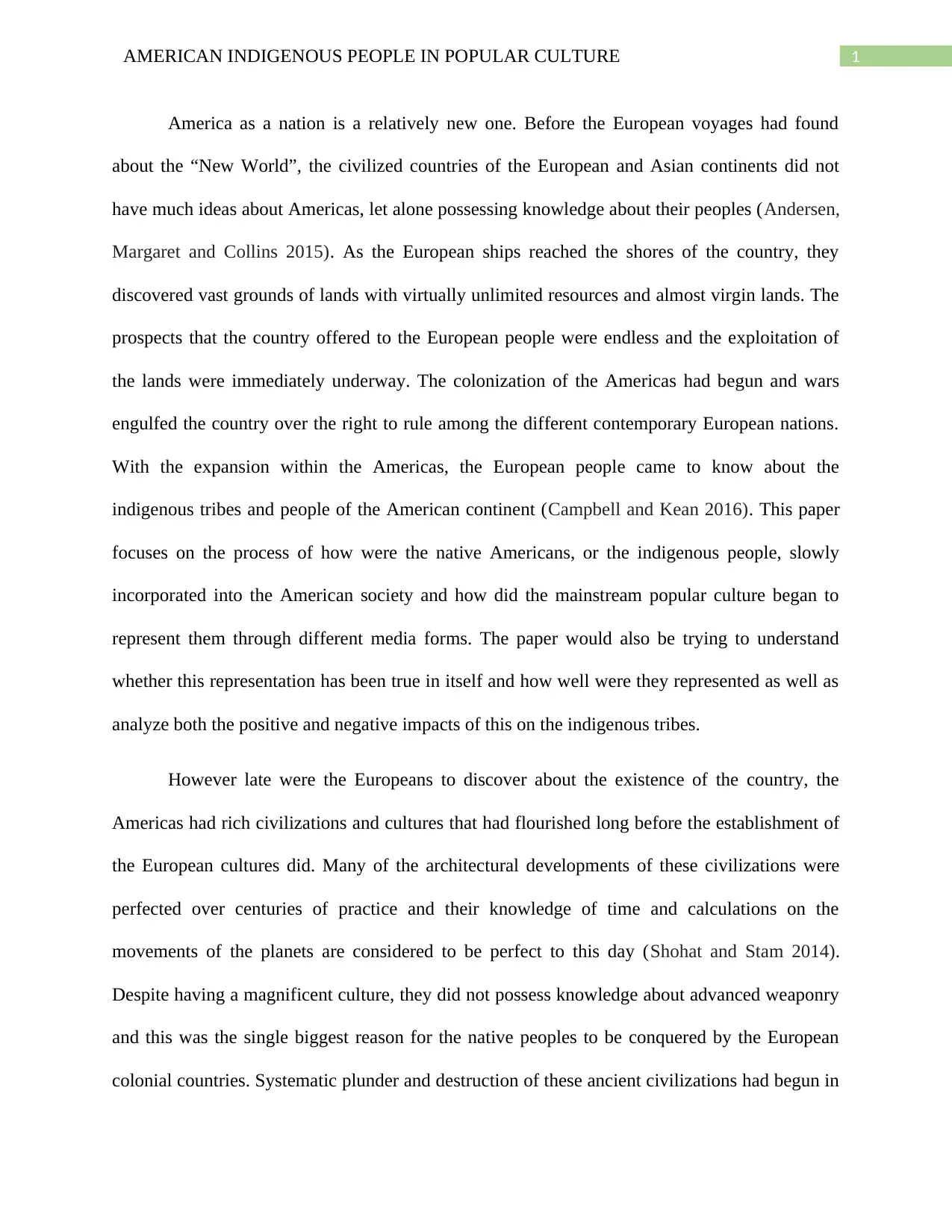
1AMERICAN INDIGENOUS PEOPLE IN POPULAR CULTURE
America as a nation is a relatively new one. Before the European voyages had found
about the “New World”, the civilized countries of the European and Asian continents did not
have much ideas about Americas, let alone possessing knowledge about their peoples (Andersen,
Margaret and Collins 2015). As the European ships reached the shores of the country, they
discovered vast grounds of lands with virtually unlimited resources and almost virgin lands. The
prospects that the country offered to the European people were endless and the exploitation of
the lands were immediately underway. The colonization of the Americas had begun and wars
engulfed the country over the right to rule among the different contemporary European nations.
With the expansion within the Americas, the European people came to know about the
indigenous tribes and people of the American continent (Campbell and Kean 2016). This paper
focuses on the process of how were the native Americans, or the indigenous people, slowly
incorporated into the American society and how did the mainstream popular culture began to
represent them through different media forms. The paper would also be trying to understand
whether this representation has been true in itself and how well were they represented as well as
analyze both the positive and negative impacts of this on the indigenous tribes.
However late were the Europeans to discover about the existence of the country, the
Americas had rich civilizations and cultures that had flourished long before the establishment of
the European cultures did. Many of the architectural developments of these civilizations were
perfected over centuries of practice and their knowledge of time and calculations on the
movements of the planets are considered to be perfect to this day (Shohat and Stam 2014).
Despite having a magnificent culture, they did not possess knowledge about advanced weaponry
and this was the single biggest reason for the native peoples to be conquered by the European
colonial countries. Systematic plunder and destruction of these ancient civilizations had begun in
America as a nation is a relatively new one. Before the European voyages had found
about the “New World”, the civilized countries of the European and Asian continents did not
have much ideas about Americas, let alone possessing knowledge about their peoples (Andersen,
Margaret and Collins 2015). As the European ships reached the shores of the country, they
discovered vast grounds of lands with virtually unlimited resources and almost virgin lands. The
prospects that the country offered to the European people were endless and the exploitation of
the lands were immediately underway. The colonization of the Americas had begun and wars
engulfed the country over the right to rule among the different contemporary European nations.
With the expansion within the Americas, the European people came to know about the
indigenous tribes and people of the American continent (Campbell and Kean 2016). This paper
focuses on the process of how were the native Americans, or the indigenous people, slowly
incorporated into the American society and how did the mainstream popular culture began to
represent them through different media forms. The paper would also be trying to understand
whether this representation has been true in itself and how well were they represented as well as
analyze both the positive and negative impacts of this on the indigenous tribes.
However late were the Europeans to discover about the existence of the country, the
Americas had rich civilizations and cultures that had flourished long before the establishment of
the European cultures did. Many of the architectural developments of these civilizations were
perfected over centuries of practice and their knowledge of time and calculations on the
movements of the planets are considered to be perfect to this day (Shohat and Stam 2014).
Despite having a magnificent culture, they did not possess knowledge about advanced weaponry
and this was the single biggest reason for the native peoples to be conquered by the European
colonial countries. Systematic plunder and destruction of these ancient civilizations had begun in
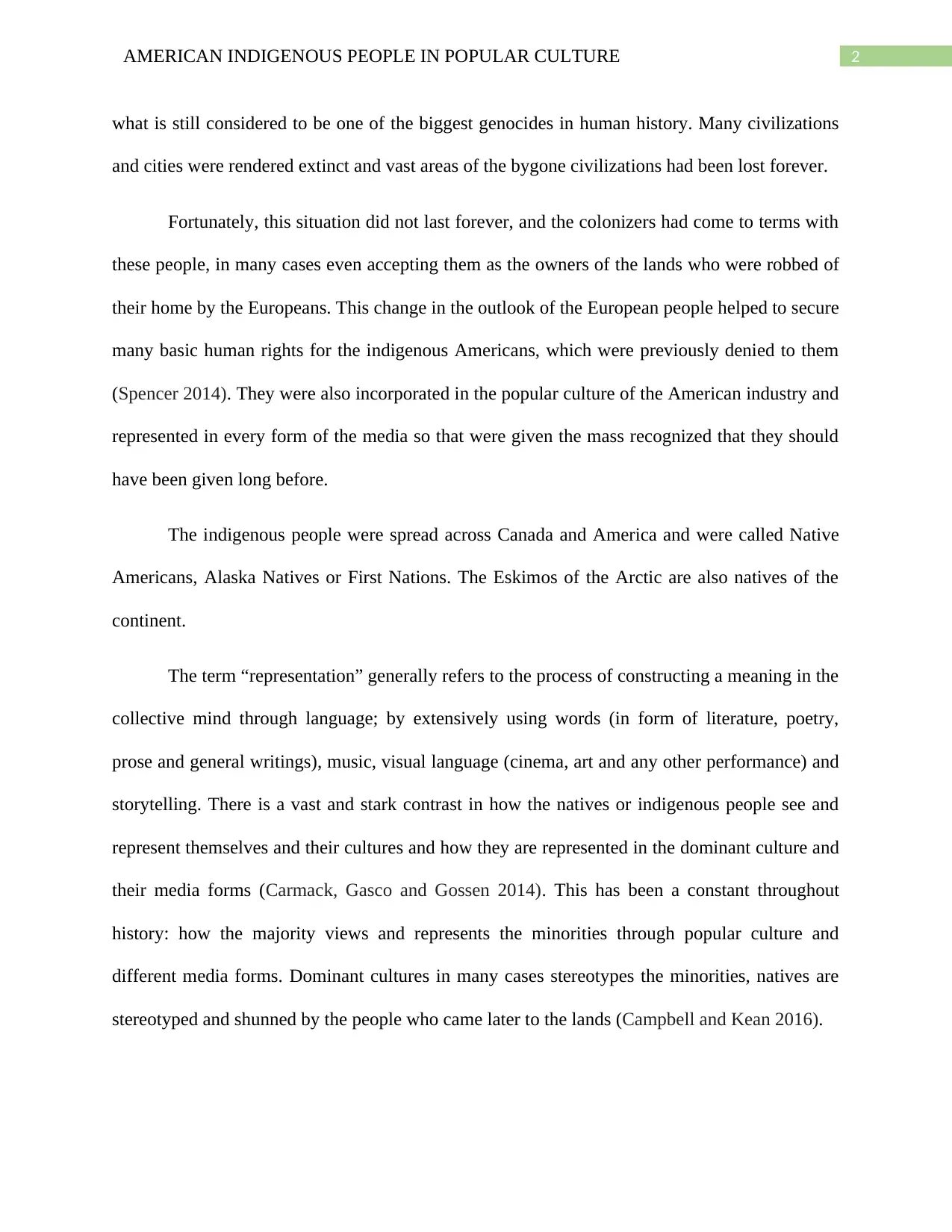
2AMERICAN INDIGENOUS PEOPLE IN POPULAR CULTURE
what is still considered to be one of the biggest genocides in human history. Many civilizations
and cities were rendered extinct and vast areas of the bygone civilizations had been lost forever.
Fortunately, this situation did not last forever, and the colonizers had come to terms with
these people, in many cases even accepting them as the owners of the lands who were robbed of
their home by the Europeans. This change in the outlook of the European people helped to secure
many basic human rights for the indigenous Americans, which were previously denied to them
(Spencer 2014). They were also incorporated in the popular culture of the American industry and
represented in every form of the media so that were given the mass recognized that they should
have been given long before.
The indigenous people were spread across Canada and America and were called Native
Americans, Alaska Natives or First Nations. The Eskimos of the Arctic are also natives of the
continent.
The term “representation” generally refers to the process of constructing a meaning in the
collective mind through language; by extensively using words (in form of literature, poetry,
prose and general writings), music, visual language (cinema, art and any other performance) and
storytelling. There is a vast and stark contrast in how the natives or indigenous people see and
represent themselves and their cultures and how they are represented in the dominant culture and
their media forms (Carmack, Gasco and Gossen 2014). This has been a constant throughout
history: how the majority views and represents the minorities through popular culture and
different media forms. Dominant cultures in many cases stereotypes the minorities, natives are
stereotyped and shunned by the people who came later to the lands (Campbell and Kean 2016).
what is still considered to be one of the biggest genocides in human history. Many civilizations
and cities were rendered extinct and vast areas of the bygone civilizations had been lost forever.
Fortunately, this situation did not last forever, and the colonizers had come to terms with
these people, in many cases even accepting them as the owners of the lands who were robbed of
their home by the Europeans. This change in the outlook of the European people helped to secure
many basic human rights for the indigenous Americans, which were previously denied to them
(Spencer 2014). They were also incorporated in the popular culture of the American industry and
represented in every form of the media so that were given the mass recognized that they should
have been given long before.
The indigenous people were spread across Canada and America and were called Native
Americans, Alaska Natives or First Nations. The Eskimos of the Arctic are also natives of the
continent.
The term “representation” generally refers to the process of constructing a meaning in the
collective mind through language; by extensively using words (in form of literature, poetry,
prose and general writings), music, visual language (cinema, art and any other performance) and
storytelling. There is a vast and stark contrast in how the natives or indigenous people see and
represent themselves and their cultures and how they are represented in the dominant culture and
their media forms (Carmack, Gasco and Gossen 2014). This has been a constant throughout
history: how the majority views and represents the minorities through popular culture and
different media forms. Dominant cultures in many cases stereotypes the minorities, natives are
stereotyped and shunned by the people who came later to the lands (Campbell and Kean 2016).
⊘ This is a preview!⊘
Do you want full access?
Subscribe today to unlock all pages.

Trusted by 1+ million students worldwide

3AMERICAN INDIGENOUS PEOPLE IN POPULAR CULTURE
The American culture, after accepting and including the indigenous people in their own
culture, has portrayed and projected vivid views of the natives to the rest of the world through
popular culture that in many cases have held salient racism features and have not been very
accurate either. For example, the great Westerns (like Buffalo Bill’s Wild West show) have
always portrayed the natives as a groups engulfed with criminal activities that are almost a sort
of malice to the American society, which is protected by the guns of the white people. In today’s
societies many of the people are exposed to the native Americans through museums and even
more so through the media. Ironically, for the United States, most of the citizens had not seen a
native Indian even by the 1830s (Lobo, Talbot, and Carlston 2016). James Cooper, one the most
famous writers who popularized the Indians in his book The Last of the Mohicans, had never
even seen an Indian in his life.
Apart from movies and other similar forms of media, the indigenous people have also
been represented through sports culture. Mascots of different sports teams have become the most
popular form of indigenous portrayal in recent times.
Another popular way that the native indigenous people are represented through media is
art forms. The earliest forms of indigenous American art include objects for personal and
community use, in embellished forms. The designs of these objects often depicted different
stories of the clans or of old folklore. Designs varied depending upon the geographical location
of each tribe. Contemporary native (TallBear 2014) American origin artists are carrying forward
this tradition and the probably the best collection of native art can be found at the Smithsonian
Institution’s National Museum of the American Indian (NMAI).
Despite the fact that there are well over five hundred indigenous tribes in the United
States itself, that are federally recognized, and many more so which are not, the natives are still
The American culture, after accepting and including the indigenous people in their own
culture, has portrayed and projected vivid views of the natives to the rest of the world through
popular culture that in many cases have held salient racism features and have not been very
accurate either. For example, the great Westerns (like Buffalo Bill’s Wild West show) have
always portrayed the natives as a groups engulfed with criminal activities that are almost a sort
of malice to the American society, which is protected by the guns of the white people. In today’s
societies many of the people are exposed to the native Americans through museums and even
more so through the media. Ironically, for the United States, most of the citizens had not seen a
native Indian even by the 1830s (Lobo, Talbot, and Carlston 2016). James Cooper, one the most
famous writers who popularized the Indians in his book The Last of the Mohicans, had never
even seen an Indian in his life.
Apart from movies and other similar forms of media, the indigenous people have also
been represented through sports culture. Mascots of different sports teams have become the most
popular form of indigenous portrayal in recent times.
Another popular way that the native indigenous people are represented through media is
art forms. The earliest forms of indigenous American art include objects for personal and
community use, in embellished forms. The designs of these objects often depicted different
stories of the clans or of old folklore. Designs varied depending upon the geographical location
of each tribe. Contemporary native (TallBear 2014) American origin artists are carrying forward
this tradition and the probably the best collection of native art can be found at the Smithsonian
Institution’s National Museum of the American Indian (NMAI).
Despite the fact that there are well over five hundred indigenous tribes in the United
States itself, that are federally recognized, and many more so which are not, the natives are still
Paraphrase This Document
Need a fresh take? Get an instant paraphrase of this document with our AI Paraphraser

4AMERICAN INDIGENOUS PEOPLE IN POPULAR CULTURE
boiled down to only a couple of stereotypes. All of these tribes have distinct cultures and
practices, and yet, popular culture only views native Americans through a very narrow lenses.
Instead of actually depicting the indigenous people or real tribal people, the popular culture
prefers to use costumes and thinks up about their characters which are mostly fantasies (Grande
2015). These cohorts of misinterpretations have a significant impact, mostly negative, on the
modern indigenous tribes, more specifically the younger generations.
When it comes to depicting the native people, the case is quite different for the tribal men
and women. The women of native American tribes are mostly shown as either debauch
characters who exploit people, are savages and participates in activities that are harmful for the
civilized society, or they are damsels in distress who are waiting to be rescued, from the shackles
of oppression, by the protagonist, most often a white male (Leavitt et al. 2015). The effects of
portraying misleading identities about the natives have significant impact upon the women in
particular. The women are always portrayed to be savages, no matter their character and nature
and in derogatory manners. Depicting the native women in this way creates for a dangerous
image of the native women in popular media and culture (Forbes and Mahan 2017). Even worse,
this creates a toxic image for the younger native women to view themselves through media as
well as promoting salient racism through the use of the stereotypical costumes.
It is not just movies, art or music that are used to represent the native Americans to the
world. Video games are also one of the major platforms that have been used by popular culture
to portray these people (Carmack, Gasco and Gossen 2014). However, video games are also not
free from the mainstream portrayal of the natives and most video games are built in a manner
that requires the players to be waging war against the native American tribes in order to conquer
their lands and oust them from their own lands to establish kingdoms. All of these media
boiled down to only a couple of stereotypes. All of these tribes have distinct cultures and
practices, and yet, popular culture only views native Americans through a very narrow lenses.
Instead of actually depicting the indigenous people or real tribal people, the popular culture
prefers to use costumes and thinks up about their characters which are mostly fantasies (Grande
2015). These cohorts of misinterpretations have a significant impact, mostly negative, on the
modern indigenous tribes, more specifically the younger generations.
When it comes to depicting the native people, the case is quite different for the tribal men
and women. The women of native American tribes are mostly shown as either debauch
characters who exploit people, are savages and participates in activities that are harmful for the
civilized society, or they are damsels in distress who are waiting to be rescued, from the shackles
of oppression, by the protagonist, most often a white male (Leavitt et al. 2015). The effects of
portraying misleading identities about the natives have significant impact upon the women in
particular. The women are always portrayed to be savages, no matter their character and nature
and in derogatory manners. Depicting the native women in this way creates for a dangerous
image of the native women in popular media and culture (Forbes and Mahan 2017). Even worse,
this creates a toxic image for the younger native women to view themselves through media as
well as promoting salient racism through the use of the stereotypical costumes.
It is not just movies, art or music that are used to represent the native Americans to the
world. Video games are also one of the major platforms that have been used by popular culture
to portray these people (Carmack, Gasco and Gossen 2014). However, video games are also not
free from the mainstream portrayal of the natives and most video games are built in a manner
that requires the players to be waging war against the native American tribes in order to conquer
their lands and oust them from their own lands to establish kingdoms. All of these media
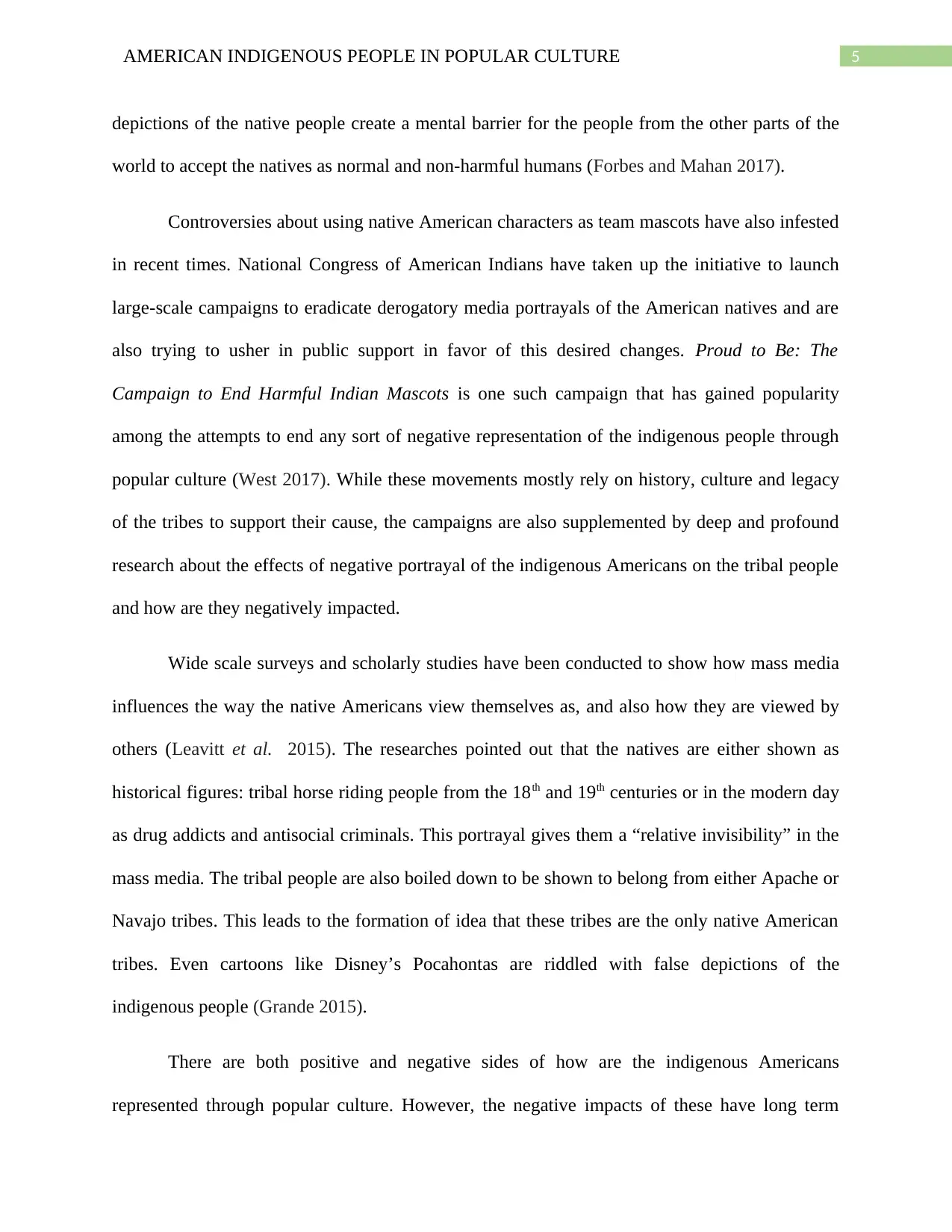
5AMERICAN INDIGENOUS PEOPLE IN POPULAR CULTURE
depictions of the native people create a mental barrier for the people from the other parts of the
world to accept the natives as normal and non-harmful humans (Forbes and Mahan 2017).
Controversies about using native American characters as team mascots have also infested
in recent times. National Congress of American Indians have taken up the initiative to launch
large-scale campaigns to eradicate derogatory media portrayals of the American natives and are
also trying to usher in public support in favor of this desired changes. Proud to Be: The
Campaign to End Harmful Indian Mascots is one such campaign that has gained popularity
among the attempts to end any sort of negative representation of the indigenous people through
popular culture (West 2017). While these movements mostly rely on history, culture and legacy
of the tribes to support their cause, the campaigns are also supplemented by deep and profound
research about the effects of negative portrayal of the indigenous Americans on the tribal people
and how are they negatively impacted.
Wide scale surveys and scholarly studies have been conducted to show how mass media
influences the way the native Americans view themselves as, and also how they are viewed by
others (Leavitt et al. 2015). The researches pointed out that the natives are either shown as
historical figures: tribal horse riding people from the 18th and 19th centuries or in the modern day
as drug addicts and antisocial criminals. This portrayal gives them a “relative invisibility” in the
mass media. The tribal people are also boiled down to be shown to belong from either Apache or
Navajo tribes. This leads to the formation of idea that these tribes are the only native American
tribes. Even cartoons like Disney’s Pocahontas are riddled with false depictions of the
indigenous people (Grande 2015).
There are both positive and negative sides of how are the indigenous Americans
represented through popular culture. However, the negative impacts of these have long term
depictions of the native people create a mental barrier for the people from the other parts of the
world to accept the natives as normal and non-harmful humans (Forbes and Mahan 2017).
Controversies about using native American characters as team mascots have also infested
in recent times. National Congress of American Indians have taken up the initiative to launch
large-scale campaigns to eradicate derogatory media portrayals of the American natives and are
also trying to usher in public support in favor of this desired changes. Proud to Be: The
Campaign to End Harmful Indian Mascots is one such campaign that has gained popularity
among the attempts to end any sort of negative representation of the indigenous people through
popular culture (West 2017). While these movements mostly rely on history, culture and legacy
of the tribes to support their cause, the campaigns are also supplemented by deep and profound
research about the effects of negative portrayal of the indigenous Americans on the tribal people
and how are they negatively impacted.
Wide scale surveys and scholarly studies have been conducted to show how mass media
influences the way the native Americans view themselves as, and also how they are viewed by
others (Leavitt et al. 2015). The researches pointed out that the natives are either shown as
historical figures: tribal horse riding people from the 18th and 19th centuries or in the modern day
as drug addicts and antisocial criminals. This portrayal gives them a “relative invisibility” in the
mass media. The tribal people are also boiled down to be shown to belong from either Apache or
Navajo tribes. This leads to the formation of idea that these tribes are the only native American
tribes. Even cartoons like Disney’s Pocahontas are riddled with false depictions of the
indigenous people (Grande 2015).
There are both positive and negative sides of how are the indigenous Americans
represented through popular culture. However, the negative impacts of these have long term
⊘ This is a preview!⊘
Do you want full access?
Subscribe today to unlock all pages.

Trusted by 1+ million students worldwide
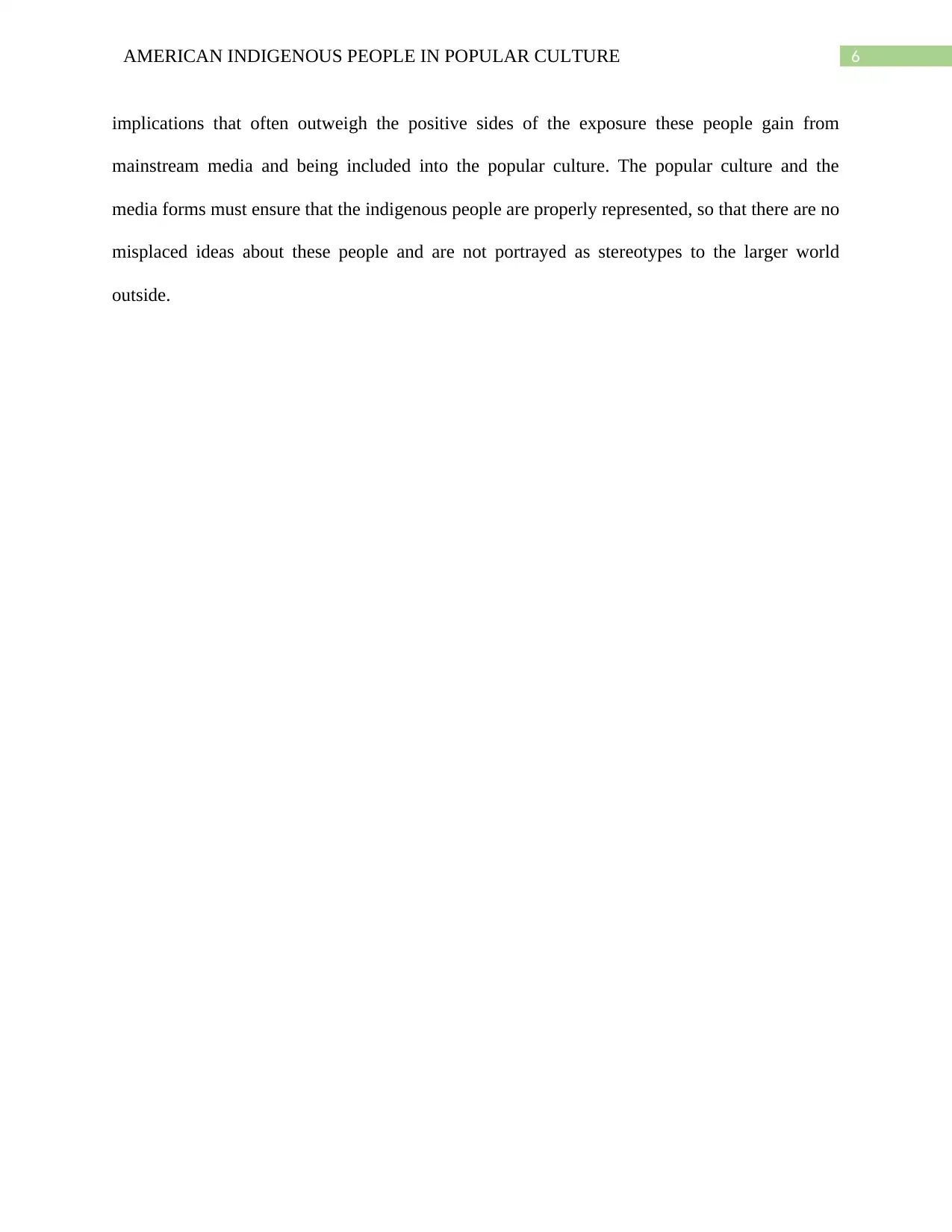
6AMERICAN INDIGENOUS PEOPLE IN POPULAR CULTURE
implications that often outweigh the positive sides of the exposure these people gain from
mainstream media and being included into the popular culture. The popular culture and the
media forms must ensure that the indigenous people are properly represented, so that there are no
misplaced ideas about these people and are not portrayed as stereotypes to the larger world
outside.
implications that often outweigh the positive sides of the exposure these people gain from
mainstream media and being included into the popular culture. The popular culture and the
media forms must ensure that the indigenous people are properly represented, so that there are no
misplaced ideas about these people and are not portrayed as stereotypes to the larger world
outside.
Paraphrase This Document
Need a fresh take? Get an instant paraphrase of this document with our AI Paraphraser

7AMERICAN INDIGENOUS PEOPLE IN POPULAR CULTURE
References
Andersen, Margaret, and Patricia Hill Collins. Race, class, & gender: An anthology. Nelson
Education, 2015.
Campbell, Neil, and Alasdair Kean. American cultural studies: an introduction to American
culture. Routledge, 2016.
Carmack, Robert M., Janine L. Gasco, and Gary H. Gossen, eds. The legacy of Mesoamerica:
history and culture of a Native American civilization. Routledge, 2016.
Forbes, Bruce David, and Jeffrey H. Mahan. Religion and popular culture in America. Univ of
California Press, 2017.
Grande, Sandy. Red pedagogy: Native American social and political thought. Rowman &
Littlefield, 2015.
Leavitt, Peter A., Rebecca Covarrubias, Yvonne A. Perez, and Stephanie A. Fryberg. "“Frozen in
Time”: The Impact of Native American Media Representations on Identity and Self‐
Understanding." Journal of Social Issues 71, no. 1 (2015): 39-53.
Lobo, Susan, Steve Talbot, and Traci Morris Carlston. Native American voices. Routledge, 2016.
Shohat, Ella, and Robert Stam. Unthinking Eurocentrism: Multiculturalism and the media.
Routledge, 2014.
Spencer, Stephen. Race and ethnicity: Culture, identity and representation. Routledge, 2014.
TallBear, Kim. Native American DNA: Tribal belonging and the false promise of genetic
science. University of Minnesota Press, 2013.
References
Andersen, Margaret, and Patricia Hill Collins. Race, class, & gender: An anthology. Nelson
Education, 2015.
Campbell, Neil, and Alasdair Kean. American cultural studies: an introduction to American
culture. Routledge, 2016.
Carmack, Robert M., Janine L. Gasco, and Gary H. Gossen, eds. The legacy of Mesoamerica:
history and culture of a Native American civilization. Routledge, 2016.
Forbes, Bruce David, and Jeffrey H. Mahan. Religion and popular culture in America. Univ of
California Press, 2017.
Grande, Sandy. Red pedagogy: Native American social and political thought. Rowman &
Littlefield, 2015.
Leavitt, Peter A., Rebecca Covarrubias, Yvonne A. Perez, and Stephanie A. Fryberg. "“Frozen in
Time”: The Impact of Native American Media Representations on Identity and Self‐
Understanding." Journal of Social Issues 71, no. 1 (2015): 39-53.
Lobo, Susan, Steve Talbot, and Traci Morris Carlston. Native American voices. Routledge, 2016.
Shohat, Ella, and Robert Stam. Unthinking Eurocentrism: Multiculturalism and the media.
Routledge, 2014.
Spencer, Stephen. Race and ethnicity: Culture, identity and representation. Routledge, 2014.
TallBear, Kim. Native American DNA: Tribal belonging and the false promise of genetic
science. University of Minnesota Press, 2013.
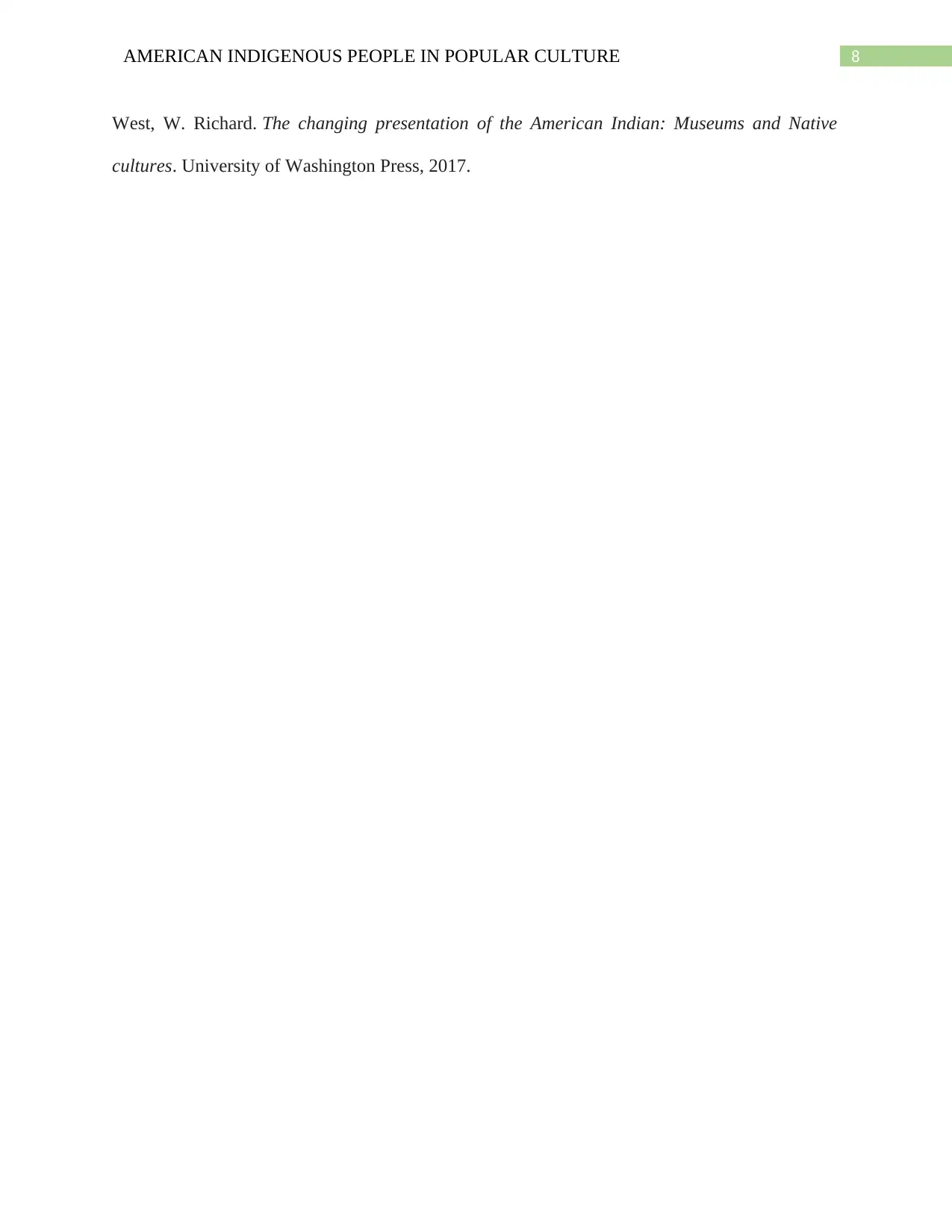
8AMERICAN INDIGENOUS PEOPLE IN POPULAR CULTURE
West, W. Richard. The changing presentation of the American Indian: Museums and Native
cultures. University of Washington Press, 2017.
West, W. Richard. The changing presentation of the American Indian: Museums and Native
cultures. University of Washington Press, 2017.
⊘ This is a preview!⊘
Do you want full access?
Subscribe today to unlock all pages.

Trusted by 1+ million students worldwide
1 out of 9
Related Documents
Your All-in-One AI-Powered Toolkit for Academic Success.
+13062052269
info@desklib.com
Available 24*7 on WhatsApp / Email
![[object Object]](/_next/static/media/star-bottom.7253800d.svg)
Unlock your academic potential
Copyright © 2020–2025 A2Z Services. All Rights Reserved. Developed and managed by ZUCOL.





